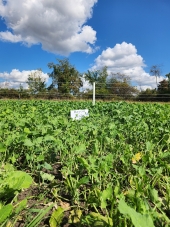
 1
1








Walter Jeffries wrote:Our pigs which are on pasture with no commercial feed reach market weight of about 250 lbs live (180 lbs hanging) in about six months, a month longer over winter. This is pretty typical. The reason is that most pigs rate of gain and gain of meat per pound of feed changes around then making that the most economical time to take them to market. This is also the age where marbling develops. You can eat a pig at any age, bigger or smaller, younger or older. Some breeds do take longer. I would suggest focusing on how the development fits your needs (time, economics, etc) rather than worrying too much about age.





 1
1




Order copies of my book, Dairy Farming: The Beautiful Way at
www.createspace.com
Help spread the word! Thanks!
struggle - hustle - soul - desire




Ari Mattathias wrote:I assume I will definitely have to replant anyway in areas where the pigs root













Ari Mattathias wrote:
The pork we did not keep sold quick, and we more than broke even. More importantly, the buyer who runs a CSA was very pleased and wants to buy more.




Scott H.
Check out my house project!




S Haze wrote:What is a good number of animals to keep as a group so that they stick together and do all their piggy work as one merry tribe? Right now I only have 4 and they seem very social and are never far apart. This seems like it makes them easy to manage although I have nothing to compare to. Maybe it depends on the breed, I just don't know. I'd like to get more but I think I'd like them to stay together as a herd. What size of groups do they live in in nature?

|
All of the following truths are shameless lies - Vonnegut
The new purple deck of permaculture playing cards
https://www.kickstarter.com/projects/paulwheaton/garden-cards
|






